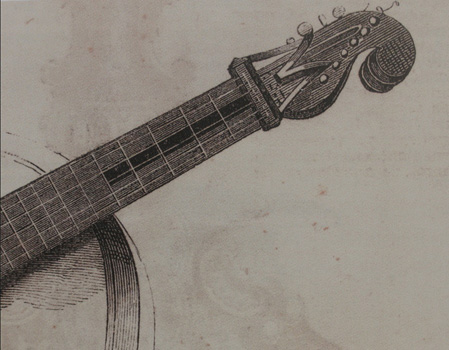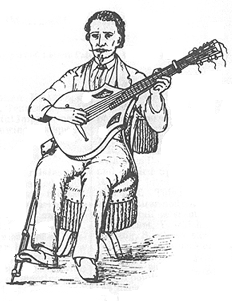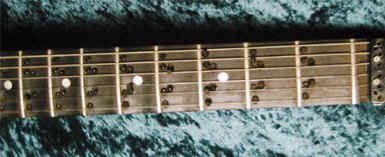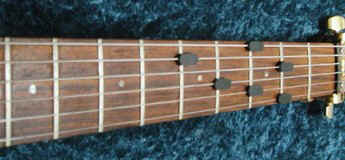![]() Capo Guitars
Capo Guitars
 |
Pedal- or Mutationsguitarre Invented by Rudolph Knaffl-Lenz and was granted a privilege 1844 in Vienna.This built in capo made it possible to play in six different keys with the same fingering. The guitar was shown at a trade show in Vienna 1845 and conserts were performed on the instrument by J. K. Mertz and Johann Decker-Schenk the same year. In this case the word pedal stands for fot or foundation, i.e. the lowest notes on the instrument. In the next case the word pedal is more concrete. |
![]()
| Click on the picture to see the whole patent drawing. |  |
| Improvements In Guitars US patent 1873 by Rudolph Knaffl of Nashville, Tennessee. |
The roller capo is pulled down the instrument neck by means of a treadle. An India-rubber spring pulled it back when the pressure on the treadle was relieved. |
![]()
The next invention - The Capo Guitar - was realized. It was marketed by
Sears in the
beginning of the 20th century.
The Capo Guitar
| Click on the picture to see the whole Sears ad. | [Source: Mugwumps] |
|
|
This capo guitar came from a wealthy family in Sewickley, PA, a suburb of Pittsburgh. It was thrown out for garbage and rescued by an old caretaker who worked on the estate. The caretaker gave it to his son, who gave it to the present owner. The capo bar was missing when the guitar was received. It had the remnant of gut strings on the keys. The top is solid spruce and the sides and back are rosewood. Mahogany neck with rosewood on both sides of the peghead. Unfortunately, someone damaged this instrument with a knife - resulting in many small holes in the top. The spring loaded capo is movable up to the 8'th fret through a slot in the instrument neck and stores behind the nut. In the ad, there is a loop handle for the thumb. However, on the real guitar there is a button. The thumb pressed the button to release the spring pressure and move the capo. The purpose of the hole in the button was to give a better grip when the capo was moved sideways. |
US patent 1902 by Ernest Robert Kappeler of Allegheny,
Pennsylvania.
Manufactured by Harmony Co and sold by Sears. Both located in Chicago Illinois.
[Owner: Dan Littler, Pennsylvania.]
![]()
Fixed Fingering Device
US patent 1987 by Leif Erich (artist name).

| Here is the first system for capoing all strings individually. Small screws are countersink into the fretboard. The screws sit at an angle to the strings and when a screw is extended the string can be hooked under the edge of the small screw head. The screws are are made of a flexible nylon type of material and are so small that you can't hardly feel them when they are deployed on the strings. The problem with this system is that it requires a small screw driver to engage/disengage the strings. The system was never marketed. |
Improved Fixed Fingering Device
US patent 1991 by Leif Erich.

| In this improved system each string is engaged by a small, slippery, flexible, thermo
plastic, single string capo that locks right onto a special fret wire. Even though the
capos extend in front of the frets, there is enough room for the string to vibrate free
all the way to the top of the fret. The system is installed by refretting the instrument
with the special frets. For standard guitars the capos have grooves for the strings so
they can be removed. If the instrument has a zero fret, the capos can be permanently
attached to the strings like beads. When not in use, the permanent capos are stored on the
zero fret. Marketed by Leif Erich. |
![]()
Abacus Capo
US patent 2000 by Jonathan Sims & Chris Sims.
| An early version (1998) has strong magnets inlayed flush into the fretboard. Each string has a corresponding capo with a hole bored in it through which the sting passes. The capo has a steel center which is attracted by the magnets in the fretboard. The capos can be slid up or down the fretboard in any combination and are stored at the nut behind a zero fret. |
|
| A later version (2003) has a stainless steel fretboard (a thin piece of metal about 1
mm thick) and the magnets are contained in the capos. The development continues... Marketed by Abacus Capo. |
![]()